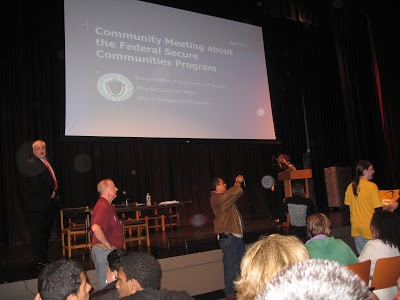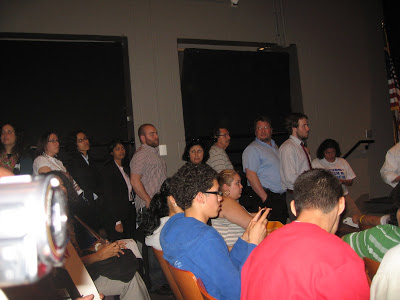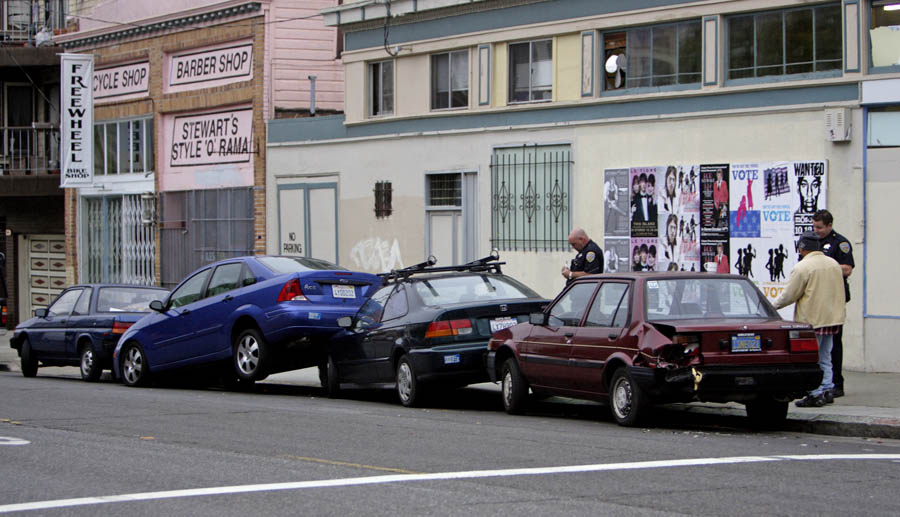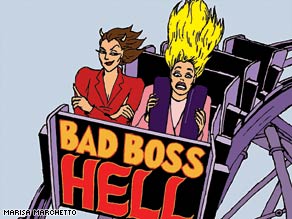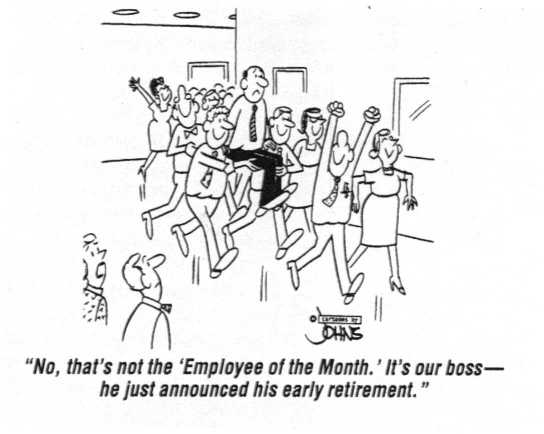WE ARE (ALMOST) ALL IMMIGRANTS…
Last night I went to a rally and public hearing in Chelsea, Massachusetts about the “Secure Communities” program. For those of you who are unfamiliar with this program – as I was up until recently – it would increase federal authorities’ access to information about immigrants who are suspected of committing a crime.
Currently, police now have the technology to take the fingerprints of crime suspects and share them digitally with other state officials around the country, to see if they surface other crimes. Under “Secure Communities”, the U.S. Bureau of Immigration and Customs Enforcement (ICE) would have access to the technology of state officials, including suspects’ fingerprints and background information.
The program was supposedly started by ICE to identify serious criminals, but it turns out that the majority of people identified by Secure Communities have minor or no criminal convictions. In fact. in Boston, where the program was piloted, over 50% of the immigrants who were arrested and deported were in this category! Nonetheless, the federal government plans to implement the program – to be administered through state agencies – by 2013.
Last night, at the Chelsea hearing, opposition to the program came through loud and clear. Over 200 people jammed into the auditorium of the local high school, mostly to voice their opposition to the “Secure Communities” program. Before the event, there was concern that the Tea Party would show up and be disruptive, as they had been at another hearing in Waltham, Massachusetts. And sure enough, a small but vocal group was there. I happened to sit next to two Tea Partiers. Given the “otherness” with which these folks are painted – and the outrageous behavior of many of their leaders – I felt a certain trepidation and immense curiosity about who they were and what they were thinking throughout the evening.
The hearing began with a public official from the state’s Public Safety office, explaining how the system functioned to track criminals. His voice was monotonous, designed to make the most patient listener edgy. Backed by an uninspired Power Point presentation, he droned on and on, and the crowd got restless. His main points, which he made over and over again, were two-fold. First of all, he said that the “Secure Communities” program only involved procedural changes that would allow state officials to share information about suspects with federal immigration officials. Skirting any potential policy implications, the official described the program as if we, the audience, were simple people who just might not understand the complexities of government. His second message was that this program was going to be implemented, regardless of public concerns, and that the role of the state was to figure out how to best accomplish this goal.
So what was the point of these hearings? Why bother asking us what we think of the program? There was something odd about this introduction that said, ‘basically, this is going to happen anyway,’ when clearly, the door for dialogue and debate is still open…
My Tea Party friends sitting next to me were busy. The woman adjacent to me was videotaping the entire event, and her partner – who carried a series of signs in support of the program – was tallying how many people spoke out for the program and how many spoke out against. Given my curiosity about them, I tried to make small connections. I asked the woman if she could lend me her pen and we smiled at one another. And when people were looking for seats, we both raised our hands and pointed to the seats in our row. I donned my sociological eye and thought of this as a “research-able moment”.
One by one, Latino immigrants shared heart-felt stories of working hard to contribute to this society and their sense of betrayal with this program. The audience cheered in support. Many shared stories of being racially profiled, or stories of friends who were deported unfairly to countries where they were not safe. Again, the audience cheered. An elderly Chinese immigrant spoke with the help of a translator, saying that we are all immigrants to this country, as the crowd stood up and burst into applause. And when he walked away from the microphone, audience members reached out to shake his hand in solidarity. Many white audience members spoke about being second or third generation immigrants, bridging the gaps between first generation immigrants and nearly everyone else in this nation. Again, the audience cheered. A lawyer from the Center for Constitutional Rights told us that there were a couple of lawsuits challenging the legality of the program, and her comments reassured the audience that there was, in fact, recourse. And several others spoke about the danger of “Secure Communities” for women victims of domestic violence as it might deter them from reporting abuse for fear of being deported if they are undocumented.
Interspersed between the 80 or more speakers who opposed “Secure Communities” were roughly 10 Tea Party speakers who supported the program. With some, it was evident that they were Tea Partiers from the moment they opened their mouths, because they started with inflammatory comments like “immigrants are criminals.” But the most controversial Tea Partier who spoke was a Latino man who loudly declared his support for the program because he said it would get rid of immigrants who were criminals. When the crowd began to “boo” him, he shouted defiantly, “Soy Dominicano y soy un Team Partier!” (I am Dominican and a Tea Partier.). And as he loped back to his seat, he nodded to his fellow (white) Tea Partiers, punching his fist in the air.
At the end of the hearing, as we were all putting on our coats and preparing to leave, I turned to my Tea Party friend and asked her what she planned to do with the video she had been shooting. She kindly responded that she would put it up on YouTube for those who weren’t able to be there. I asked if she was a member of the Tea Party, to which she answered, yes, and then replied by asking if I was in the Tea Party too! That surprised me, and made me realize that she wasn’t paying any attention to my hoots of support for those who opposed the program! I wondered what she was thinking about what she had just heard. After all, we had both spent the past hour listening to the same speakers and many of their compelling stories. So I asked her if any of these stories had moved her to think differently. She looked at me with a pained expression, and said, yes, particularly the women who were victims of domestic violence. ‘But what can we do?,’ she implored. ‘We need to deal with the criminals! We need to change the police chiefs!’, she exclaimed. And with that, we walked in separate directions.
NOT FOR SISSIES…
I will try again, this time with one of those other concoctions. As you might imagine, there’s a lot of chit-chat on the web about which ones are better and worse. Personally I would go for the horse pills, but my doctor doesn’t use them. Darn. As Bette Davis said, “Old age is no place for sissies.” And getting there isn’t either…
Save the arts because the arts save lives…
The current federal budget reflects significant cuts in arts education funding. Why? Because the arts and arts education are seen by some as non-essential. But given the heavy test-laden school climate aimed at improving the education of our children, arts education is anything BUT non-essential!
“Their feelings and emotions about the plays were linked to achieving deeper understanding of Shakespeare’s plays and were often a critical entry point to engagement with the plays.” (Harvard Project Zero)
I observed a fascinating unit created by a science specialist and classroom teacher about the solar system, which incorporated a “sensory walk” and other visual arts experiences. They had a great time developing their audio for the “walk” using garage band. Not only did they enjoy preparing for this unit; they both agreed that their elementary age students were far more engaged and better understood the material after this exploration.
We have a lot of educating and advocacy to do before the federal budget is finalized! House Republicans cut $40M out of a relatively small $168M annual budget for the arts, although this cut is subject to Senate negotiations. And Obama’s proposed 2012 budget calls for a $22M reduction. Others would like to put all arts funding on the chopping block, including Sarah Palin, who told Fox News’ Sean Hannity that government spending on the arts is “frivolous.”
Home…
Joan and Warren lived next door. They were in the first-floor apartment of a modest, fading yellow, two-family house. Father and daughter, they had been living in that apartment for some 15 years. Before that, they lived in an apartment down the street, but the landlord raised the rent far beyond their means, and gave them no option but to move out. At the time, the neighbors were outraged. In their neighborhood, they said, people stayed forever, so the idea that a landlord could throw out one of their own was antithetical to “how things were done around here.” Shunning the landlord, the neighbors banded together and found them another apartment right down the street. When Joan and Warren moved into the faded yellow two-family, they pledged never to move again. People lived their whole lives in this neighborhood. Why shouldn’t they?
Despite an age gap of 30 years, many people mistook Joan and Warren for husband and wife. Maybe it was how they related to one another; maybe it was how they finished each other’s sentences, or made similar sarcastic jokes with a twinkle in their eyes. Joan and Warren even looked alike. Not just a little alike, but a lot alike, with but a few distinctions. Warren was large and tall to Joan’s short and stout. Joan hid her plump body in old wool, Catholic-plaid smocks, and comfortable old sweaters that united any division between breasts and belly. Warren wore flannel shirts and baggy pants, held up by a worn leather belt that had an extra six inches hanging off the buckle. Both of them had chins that receded into their necks, doubling and tripling in folds of skin. But Joan’s chin was framed by curly, blond waves and Warren always covered his head with a railroad hat he constantly readjusted.
According to Harvard University-based psychiatrist George Vaillant, who studied the lives of 824 men and women over a 30-year period, “objective good physical health (is) less important to successful aging than subjective good health.” In other words, older people continue to function pretty well, as long as they don’t feel sick, and while we didn’t know much about Warren’s health, he certainly did not project the image of a sick man.
My daughter once interviewed Warren for an elementary school project, one of those-talk-to-someone-who-lived-through-the-war assignments. When we rang their doorbell, we could hear Warren shuffling slowly to open the door, accompanied by the thump-thump of his cane. Opening the door with a welcoming smile, we could see that he was tickled we were there. And as we entered their cluttered, old-fashioned apartment, we were struck by the sweet smell of Joan’s homemade brownies she had baked for this special occasion. As my daughter nervously prepared to ask her questions, Warren said self-deprecatingly, “What do I have to say?”, with the emphasis on the word, “I”. And then he launched into stories of his past.
Finally, the house went on the market, and for two weeks, hoards of buyers came and went, gliding with ease through the upper two floors of this simple home, its rooms clean and ready for the next owner. They seemed to save their perusal of the first floor until last, more daintily tiptoeing through Joan and Warren’s apartment, which was cluttered with memorabilia, dusty with age and daily living.
When they reached the living room, there sat Warren, firmly planted in front of his television set, refusing to move to make it easier for real estate brokers to “show” the house. He was a part of the house, almost seemed like he came with it, one might say. So why should he move, just so some rich people could sashay through the house, looking at its “potential”. As the days progressed and no one had ostensibly made an offer on the house, there was rumor that maybe the market had slowed down. But after a couple of weeks, the house sold at a good profit.
Would it be too simple to say that gentrification killed Warren? It would be hard to make the causal connection, but perhaps there is a correlation, as Warren was forced to experience the stress of losing his home, again. Ironically, Warren was right when he claimed that this was going to be his last home. Ultimately, the power of the market won, as the highest bidder got the house, and with it, the legal right to determine whether or not to raise the rent, or for that matter, to take over the whole house. That evening, my daughter remembered that she had the tape from her interview with Warren, and asked if she could give it to Joan. “Sure,” I said, “but let’s wait a little while.”
My father’s legacy…
My father just died. My 98-year-old, fearless, outspoken father – who was devoted to fighting for the rights of workers – just died. He hung on for over a year, despite major organ failure, with incredible determination and will. Just the way he lived. Even towards the end, despite the challenges and limitations to his body and mind, he was energized by the protests in Wisconsin, as state workers – police, firefighters, nurses and more – fight to maintain their right to bargain collectively.
 In the 40s and 50s, my father was unafraid to speak up for working-class people who toiled in factories. This was his organizing base, and as a child of the 50s, it seemed very foreign to me in my middle-class world. I was schooled by the antiwar movement, the women’s movement and gay/lesbian rights movement, all a far cry from the world of factory workers who made auto or typewriter parts.
In the 40s and 50s, my father was unafraid to speak up for working-class people who toiled in factories. This was his organizing base, and as a child of the 50s, it seemed very foreign to me in my middle-class world. I was schooled by the antiwar movement, the women’s movement and gay/lesbian rights movement, all a far cry from the world of factory workers who made auto or typewriter parts.  |
|
| Manny speaking before House Un-American Activities Committee 1964 |
| Manny receives Joe Hill Award from AFL-CIO Labor Heritage Foundation |
The kindness of strangers…
This past weekend, I visit my nearly 100-year-old dad who is now in home hospice in an assisted living facility. With several major organs failing, he remains the perennial survivor. As a literary guy, he always used to quote Dylan Thomas, saying: “Do not go gentle into that good night.” And he continues to hold on…
I leave his apartment after my visit, feeling both a sense of relief as well as a deep sadness, even though I know I will see him in two weeks (assuming…), and that meanwhile, he is being well-cared for. As anyone who has taken care of an older person knows, caregiving is stressful, and caregiving from afar has its special stresses.
The ride to the airport is straightforward in this small city. It’s always a bit nostalgic as I pass by my father’s old house, where he continued to live alone up until two years ago, when we moved him into assisted living. As I pass the old street, I call my husband to let him know my plane is delayed, ignoring the state’s anti-cell phone law. (Okay – I know it’s unsafe, but I was at a stoplight!). And then it happens – BOOM!
I feel my car being hit from behind. I say matter-of-factly, ‘Oh my G-d, I was hit. I’ve got to go.’ And then my car gets hit again! I manage to move into the next lane, and this car keeps charging forward, hitting the car that was in front of me.
I jump out of the car, realizing that I’m okay, but see that my rental car is not. The driver responsible for all this reckless bumper car action is an older man, probably in his 80s. I tell him to pull over and then follow him. Turns out that he had put his foot on the accelerator instead of the brake! He claims that his foot was stuck. He is on his way to visit his wife’s grave. She had died six years ago, and he has borrowed his son’s car to get there.
The front bumper on his car is mottled, but aside from being stunned, he isn’t injured. Of course, what happens with him and his son is their next chapter, not mine, and I can only imagine. (Will the man continue to drive? With the son lend him his car? I hope not…) With this crash, we are connected by our humanness – this elderly man who is grieving for the loss of his wife, and I, who am grieving for the gradual loss of my father.
But there isn’t time to meander. My flight is leaving soon. I get advice from the rental car company about information I need from this guy, and after well wishes, I move on, driving down the highway, with half of the bumper hanging off my rental car.
As I enter the airport roadway, I call the rental car company. Like relay racers, they are ready and waiting, as papers fly between us and I gather my luggage. Running to the ticket counter, I arrive out of breath, only to be told that boarding for my plane is closed, and it’s too late to get on the flight. I plead for the airline worker to do something, sputtering fragmented sentences about my dying father and my accident. Just an instinct to use a sad story to manipulate authority… And then out-of-the-blue, another kind airline worker intervenes and calls the gate and tells them to hold the flight for me. Just for ME!
They tell me to HURRY to the gate! I get through security as quickly as one can get through security, run up to the gate, heart beating wildly, and apologize to the airline worker for holding up the flight. She looks at me whimsically, and says with humor, “Oh yeah, the whole flight is waiting just for you!” It turns out that they have not even started to board the plane. In fact, I have about 20 more minutes to wait. With that relief, I blurt out my story again, and this time, start to cry. For a moment, she looks me straight in the eye, and then she wraps her arms around me, saying, “I’m such a softy. I feel like crying with you!” And we do. Me and an airline employee!
Today, the airline gave me a $50 credit for the “inconvenience you recently experienced with us.” So thank you, Jet Blue worker and thank you, Jet Blue.
But most of all, I am grateful that in the midst of the challenges of caregiving, I have encountered people – strangers – with whom I connect, who gracefully help to diffuse those challenges.
Progressive family policies that are close to home…
A number of years ago, I was invited to the Pentagon to talk about a work and family study I was conducting. Anyone who knows me may find this fact pretty incongruous. But I was intrigued to find out about the human resources side of the military. Given my history of antiwar and women’s rights activities – and the fact that my father had been subpoenaed to appear before the House Un-American Activities Committee in the 1950s – I fully imagined that I wouldn’t make it through the security screening. But, to my surprise, I sailed through. I found myself being chaperoned through dingy hallways to a very nondescript office for a meeting with a powerhouse of a woman who headed up programming on family supports for military “members” and their families.
Over the next two years, I worked with her and a real live Colonel, a kind and gentle soul who was an expert on domestic violence issues in the military. Our work together focused on assessing how well various military family support agencies were able to collaborate. Their “mission” was to support families through the challenges of dealing with deployment and loss.
I initially felt like a fish out of water working within this institution. But I soon connected with the human dimension and discovered that within the military, there are people from incredibly diverse backgrounds – including political perspectives – who really care about people’s well-being. I also learned that the military has far more progressive family policies than governmental policies in the civilian sphere, which rely on a hodgepodge of precarious private and public funding to service those in need.
I discovered, for example, that the military provides high-quality, affordable and accessible childcare in which early childhood teachers are paid good wages. According to Gail Zelman and Susan Gates, researchers at RAND,
“While there are no easy or obvious solutions to the childcare problem, policymakers can look to an unlikely source from ideas about improving childcare: the military. The US Department of Defense (DoD) has succeeded in optimizing the three key aspects of child care delivery – availability, quality and affordability – a juggling act unduplicated anywhere else in the country. The system currently meets around 60% of the assessed need, serving about 176,000 children 6 weeks to 12 years old in 900 centers and in 9,200 family child care homes nationwide. (Family child care homes are usually run by military spouses.)”
Let’s be honest here: The military’s desire for high levels of productivity and commitment among its members – and the need for support from military family members – are the drivers underpinning military support for these policies.
So what can policymakers learn from DoD’s experience, ask researchers Zellman and Gates?
“The clear message is that affordable, high-quality child care requires a system level commitment to quality, as well as incentives and funding to make it a reality.”
In contrast, our “civilian” child care system in the U.S. is underfunded and suffers from lack of quality, which can largely be attributed to low wages and inadequate support for its workers. In fact, the turnover rate of early childhood teachers in the U.S. is between 25-30%. Research points to a “turnover climate” which affects overall program quality. One study found that highly trained teachers (BA level or higher with specialized training) “were more likely to leave their jobs if they earned lower wages, worked with fewer highly trained teachers and worked in a climate with less stability.” (Whitebook, at al, 2001). Therefore, worker retention is linked to the stability of the program and ultimately, to higher quality.
In addition to high quality, affordable child care, the military offers paid parental leave and universal health care. Ironically, when progressives promote these policies at the federal (civilian) level, conservatives cry ‘socialism!’
In a memo entitled, “For Our Air Force Family,” Lieutenant General, USAF, Assistant Vice Chief of Staff, Joseph H. Wehrle, Jr., says,
“The United States Air Force is committed to taking care of its own. Steadfast, homefront support is provided to family members by the Integrated Delivery System… As always, we remain One Force, One Family.”
in the military, the credo – “We take care of our own.” – is motivated by the belief that this will support “readiness” for battle, increase productivity, reduce turnover, and ease the process of leaving one’s family behind to put oneself “in harms way” around the globe.
Without such immediate drivers in the corporate or non-military governmental sphere, it is hard to make the case – or as human resource professionals would say, the business case – for progressive family policies. But we don’t have to only look to Europe for inspiration around family policies; we can look to the U.S. military to find some of the most progressive policies in this nation. Don’t we all deserve them?
Knitting through the storm…
My grandmother survived the pogroms of Eastern Europe, a solo journey to America at age 13, and my grandfather, who is one of the grumpiest men I’ve ever met. But until the day she died, just shy of 100 years old, she was an avid knitter, spewing out afghans, sweaters and socks to keep her brood of nine children clothed and warm. Lucky me received one of her gems at age 20, a very tidy little blue cardigan that I have to this day.
I never really thought of my grandmother when I started to knit. It just seemed like a fun thing to do with my daughter, with whom I used to “co-knit” scarves that were more about process than product.
Several months ago, a friend, whom I will call my “knitting guru”, pulled together a group of women to knit caps for a special neighbor friend who was going through chemo. I was driven by the mission and inspired by the camaraderie of the group, and managed to make several hats for our friend. They were full of flaws, but beautiful, nonetheless (if I do say so myself!). We all read Kyoko Mori’s book, “Yarn: Remembering the Way Home”, a memoir that is framed by lessons she learned from her knitting experience. I was most touched by her recognition that mistakes are okay. I realize that this sounds pretty basic! But somehow knitting lends itself to metaphors that speak to the heart. For example,
* Individual pieces of yarn weave together and create something beautiful and new.
* Sometimes, when you make too many mistakes, you just need to undo what you’ve done and start over.
* When a ball of yarn gets really knotted, it takes a long time to undo the knots.
See what I mean? Once I got the knitting bug, I discovered a world of knitting addicts (we are everywhere!) who find pleasure – as do I – in color and texture, and creating usable objects that people want to wear! What a concept! I also discovered that the process of knitting is meditative, relaxing, invigorating, all-consuming, jitter-reducing, anxiety-protecting, and creative. Once you’ve gotten past stage one, you can actually talk and knit, which is also incredibly satisfying…
When I told my college-age daughter I had started to knit again, she expressed concern that I was – in short – getting old. Despite my arguments that knitting was the “new cool”, she had conjured up images of me as a doddering old grandmother, content with my yarn and needles. Alas, when she saw the hats I was making, she put in a request for a sweater, and lo and behold, she started to knit too!
My first three hats went to my friend who had lost her hair. The next three were sold to neighbors during an “open studio” event, in which people stroll through the ‘hood and view art on display in and around people’s homes. These folks actually paid money for my hats! The next batch went to my family. My father – nearly 100 years old – had moved to assisted living and I had started flying to visit him every other weekend.
I made four hats for the cousins who house me when I’m visiting him. They call them their “Mindy’s.” I’ve made five hats for my immediate family, including my husband and sister. And I finally made a hat for my father, who, after seeing all this knitting action, said he’d like “a Mindy” for himself. I also made several hats for my daughter’s friends and a neighbor. The next few hats will be for the amazing people who care for my father nearly 24/7, keeping him alive with their love and attention.
When I think I’m done making hats – after all, there are a lot of other interesting things to make – someone else puts in an order. And I’m grateful for it…
Bad bosses…
We’ve all had them, and maybe some of us are them! (No, not us!) As a sociologist who has spent many years studying workplaces, I am indebted to a number of bad bosses. Although some of them made my life miserable, they inspired me to understand why. So in the spirit of acknowledgment, I must first say thank you to the boss who told me I was destroying my life by leaving the job to pursue another direction. (Destroying whose life?) And thank you, too, to the psychotic boss who knew that I supported a particular political cause, and out of nowhere screamed at me, “Don’t ever let me see you on television with a sign in your hands supporting that Communist (crap).” Whoa! It hadn’t occurred to me, but now that you mention it…And thank you to the newly appointed manager who, in her first month on the job, falsely accused me of serious financial improprieties. (One month, and many sleepless nights later, I was vindicated.)
Given these experiences, it has been therapeutic to study the American workplace and to dissect some of the problems that contribute to “bad-bossism.” Despite having been “stung” by a few bad bosses, I still believe that people – including some bad bosses – are basically good.
So what is it that leads some people in management positions to “behave badly?” Well for a start, the workplace is a microcosm of our larger culture and society. Societal problems that exist outside the office are likely to surface within it as well, playing out via power dynamics between and among employees, based on their occupational status, their gender, and their racial and ethnic backgrounds.
Political economist and philosopher, Karl Marx, laid the groundwork for understanding the intrinsic tension between labor and management (or, as he would say, capital), in which a capitalist system favors profit over people. In this system, he argued, management would necessarily exploit workers with long hours and poor working conditions, in order to get more productivity out of workers, which in turn would maximize profit. With the advent of laws that limit working hours in manufacturing settings, and the regulation of working conditions, Marx’s critique and analysis continues to provide a useful framework, even though it’s probably more relevant to manufacturing work in Third World countries, where many multinational corporations have moved their operations in search of cheaper labor.
In the U.S., our current economy has increasingly shifted to knowledge-based work and services, and the lines that are drawn between workers and managers are often painted as more subtle. Nonetheless, stratification of the labor force ripples through multiple levels of professional and managerial workers. How do these dynamics affect the contemporary workplace?
Studies suggest that a number of factors shaping workplace environments contribute to the “bad boss” phenomenon:
1. Male model of the ideal worker
In this model, the “normal” trajectory of the worker is based on a “male model” of the ideal worker, a person who can work throughout his (her?) career in a continuous and uninterrupted manner, taking no time for non-work (e.g., personal, family) activities. Sociologist Erin Kelly, et al calls it a “masculinist work culture”, commenting,
“Working long hours is a sign that employees are readily available and eager to meet others’ needs; it further reinforces the ideal worker as someone – most often a man – who does not have, or does not attend to, other pressing commitments outside of work.”
With this model, work comes first. When managers perceive that’s not the case for one or more employees, it’s viewed as an affront to the company, a deviation from employee loyalty. Managers who “buy into” a “masculinist work culture” are likely to be critical of workers who challenge this norm. In a study I conducted on parental leave policy in a large financial services company, the norm was so powerful that men chose not to use the company’s generous parental leave policy, and women who used the policy took very short leaves, even though legally, all employees were entitled to longer leaves.
2. Structural issues that create a culture of competition
in our current American workplace, where the bottom line rules, there are economic pressures to produce. In line with the prevailing capitalist ethic, a culture of competition is viewed by many managers as necessary to foster productivity, with long hours as the norm. In order to sustain productivity, managers feel pressure from above to push employees to produce more, even when they realize that it’s not humanly possible. In a number of the workplace studies I’ve conducted, I’ve learned that being in a middle managerial position is often isolating. This makes these managers depressed and grumpy. Most have little support to figure out a better way, and they realize quickly that too much empathy for their “subordinates” takes too much time. Ergo, they may “act badly.”
3. Poor economic times makes managers even more grumpy
In our crisis economy, the financial pressure is even more intense, and some managers may exhibit more controlling behavior towards their employees. Managers are being more closely monitored on financial performance, and they may be even less likely to take the time to attend to employees’ feelings or needs under these conditions.
4. “Deal with it; I did!”
Some managers worked hard to get where they are, and along the way, they experienced a lot of pain themselves. When they get to the top (or close to it), some pass on what is familiar. While many of the managers I’ve interviewed worked very hard to respond to the needs of those under their supervision, some were less than understanding.
5. Lack of management training
Some managers who are good workers are rewarded by being moved up to management positions. While some organizations prepare their workers for this type of promotion, others fail to prepare them for the pressures they encounter once they are in charge. Without adequate management training, some bosses make mistakes, even lots of mistakes. Sometimes they find themselves in positions of power and it feels uncomfortable. They’re being asked to do things with and to workers that they wouldn’t have liked themselves. They know that. But they don’t know how to challenge or work with the system without jeopardizing their reputation or losing their jobs. This can make for frustration and grumpiness.
6. Personality problems
Some managers just shouldn’t be managing people. Their “management style” may look good to upper-level managers because it fits in with a culture of competition and drive. But they may be making the people who work for them miserable. Because of an “us” and “them” dichotomy, other managers may even side with them.
Perhaps we all have a story about the crazy or mean or incompetent boss. Are all managers bad bosses? No, of course not. But the problem is clearly pervasive: Google “bad boss” and you’ll find over 7 million citations, with countless workers publicly venting about their negative experiences, and experts offering advice on how to deal with that mean and disrespectful supervisor.
What is a good boss? There’s plenty written about good bosses as well. Google “good boss” and you’ll find over 14 million citations! Hopefully we’ve also had them (and maybe even are them!).
Here’s an excerpt (slightly tweaked) from an 10/10/10 article in the Chicago Tribute by Mary Schmich about what makes a “good boss.”
* A good boss understands that all power is fleeting and borrowed, and doesn’t take advantage of this moment.
* A good boss realizes that her/his real power comes not from those above him, but from the rank-and-file.
* A good boss listens, and can see a problem before it turns into a crisis. If it does turn into a crisis, the good boss works with an employee to resolve the situation.
* A good boss understands that your time is important too.
* A good boss is a good communicator, responding to your concerns and questions in person and via electronic communications.
* A good boss treats employees with respect. S/he does not treat people differently based on their occupational status, gender, race or sexual orientation.
* A good boss tries to make everyone feel special and included.
* A good boss is self-aware and tries to understand how his/her behavior affects others.
* A good boss has the courage to deal with problem employees, and does it professionally.
* A good boss tells you when you screwed up and forgives you.
* A good boss does not take credit for your ideas, nor does s/he demand credit when s/he gives you an idea.
* A good boss is not afraid of people as smart as s/he is.
* A good boss sees what you do best, matches your job to your talents, and gives you room to bloom.
* A good boss remembers how s/he felt about bosses before s/he was one.
* A good boss reveals just enough about her/his personal life to remind you that bosses are people too.
* A good boss doesn’t take bonuses when the workers can’t get a raise.
* A good boss knows how to apologize and how to laugh, sometimes at him/herself.
* And a good boss understands how much we all yearn for a good boss.




